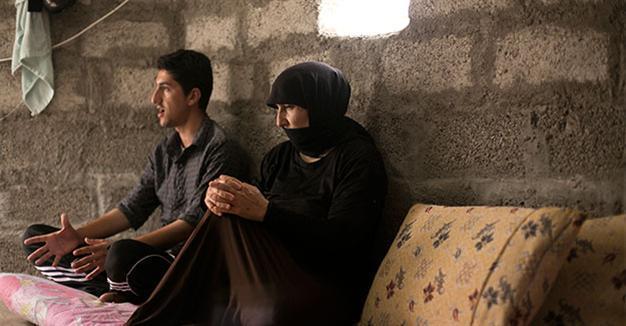ISIL buried thousands in 72 mass graves: Report
HARDAN - The Associated Press

In this May 18, 2016 photo, Nouri, right, and her son speak to the Associated Press at Kankhe Camp for the internally displaced in Dahuk, northern Iraq. Her husband, Murat Mahmoud, was killed on Aug. 3, 2014, by Islamic State militants in a massacre of Yazidis. Their bodies are buried in a mass grave at the farm where they died, the family said. AP photo
Surrounded by smoke and flames, the sound of gunshots echoing around him, the young man crouched in the creek for hours, listening to the men in his family die.On the other side of the mountain, another survivor peered through binoculars as the handcuffed men of neighboring villages were shot and then buried by a waiting bulldozer. For six days he watched as the extremists filled one grave after another with his friends and relatives.
Between them, the two scenes of horror on Sinjar mountain contain six burial sites and the bodies of more than 100 people, just a small fraction of the mass graves Islamic State Og Iraq and the Levant (ISIL) extremists have scattered across Iraq and Syria.
In exclusive interviews, photos and research, The Associated Press has documented and mapped 72 of the mass graves, the most comprehensive survey so far, with many more expected to be uncovered as the Islamic State group’s territory shrinks. In Syria, AP has obtained locations for 17 mass graves, including one with the bodies of hundreds of members of a single tribe all but exterminated when IS extremists took over their region. For at least 16 of the Iraqi graves, most in territory too dangerous to excavate, officials do not even guess the number of dead. In others, the estimates are based on memories of traumatized survivors, Islamic State propaganda and what can be gleaned from a cursory look at the earth. Still, even the known victims buried are staggering - from 5,200 to more than 15,000.
Sinjar mountain is dotted with mass graves, some in territory clawed back from ISIL after the group’s onslaught against the Yazidi minority in August 2014; others in the deadly no man’s land that has yet to be secured.
The bodies of Talal Murat’s father, uncles and cousins lie beneath the rubble of the family farm, awaiting a time when it is safe for surviving relatives to return to the place where the men were gunned down. On Sinjar’s other flank, Rasho Qassim drives daily past the graves holding the bodies of his two sons. The road is in territory long since seized back, but the five sites are untouched, roped off and awaiting the money or the political will for excavation, as the evidence they contain is scoured away by the wind and baked by the sun.
“We want to take them out of here. There are only bones left. But they said ‘No, they have to stay there, a committee will come and exhume them later,’” said Qassim, standing at the edge of the flimsy fence surrounding one site, where his two sons are buried. “It has been two years but nobody has come.”
ISIL made no attempt to hide its atrocities. In fact it boasted of them. But proving what United Nations officials and others have described as an ongoing genocide - and prosecuting those behind it - will be complicated as the graves deteriorate.
“We see clear evidence of the intent to destroy the Yazidi people,” said Naomi Kikoler, who recently visited the region for the Holocaust Museum in Washington, D.C. “There’s been virtually no effort to systematically document the crimes perpetrated, to preserve the evidence, and to ensure that mass graves are identified and protected.”
Then there are the graves still out of reach. The Islamic State group’s atrocities extend well outside the Yazidi region in northern Iraq.
Satellites offer the clearest look at massacres such as the one at Badoush Prison in June 2014 that left 600 male inmates dead. A patch of scraped earth and tire tracks show the likely killing site, according to exclusive photos obtained by the imagery intelligence firm AllSource Analysis.
Of the 72 mass graves documented by AP, the smallest contains three bodies; the largest is believed to hold thousands, but no one knows for sure.
On the northern flank of Sinjar mountain, five grave sites ring a desert crossroads. It is here that the young men of Hardan village are buried, under thistles and piles of cracked earth. They were killed in the bloody ISIL offensive of August 2014.
Through his binoculars, Arkan Qassem watched it all. His village, Gurmiz, is just up the slope from Hardan, giving a clear view over the plain below. When the jihadis swept over the area, everyone in Gurmiz fled up the mountaintop for refuge. Then Arkan and nine other men returned to their village with light weapons to try to defend their homes.
Instead, all they could do was watch the slaughter below. Arkan witnessed the militants set up checkpoints, preventing residents from leaving. Women and children were taken away.
Then the killings began. The first night, Arkan saw the militants line up a group of handcuffed men in the headlights of a bulldozer at an intersection, less than a kilometer down the slope from Gurmiz. They gunned the men down, then the bulldozer plowed the earth over their bodies.
Over six days, Arkan and his comrades watched helplessly as the fighters brought out three more groups of men - several dozen each, usually with hands bound - to the crossroads and killed them. He didn’t always see what they did with the bodies. One time, he saw them lighting a bonfire, but he couldn’t see why.
















